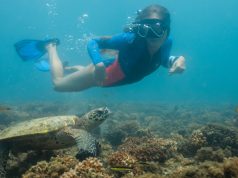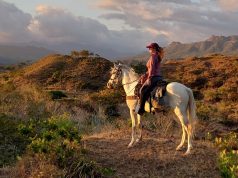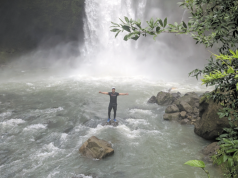Rivers, waterfalls, mangroves, beaches and mountains throughout the province. Ecological activities for everyone.
Its geographical position favors the access to the sea both to the Pacific (350 km of coastline) and to the Atlantic (60 km of coastline). It is located 250 km from Panama City, has more than 410 kilometers of coastline and beaches and 40 islands, generating ecotourism development attracting thousands of tourists a year.
Explore Veraguas, is its slogan as a tourist brand, which promises endless adventures in territories not often visited in previous years, and which now has the endorsement of MiAmbiente, so that more tour operators can take groups of people willing to camp in the islands or wooded areas.













Emblematic Places
Veraguas also promotes religious, rural, agro tourism and historical tourism, around beautiful towns with picturesque houses, clean streets and points of interest for nationals and internationals who seek colonial, indigenous and baroque art in well-preserved buildings.
- Normal de Santiago School: declared a national historical monument (1984), it is the only school where Panamanian teachers and professors are trained. It is the largest in the interior of the country and the most important educational center. Its full name is Juan Demosthenes Arosemena Normal School, in homage to its creator.
- Atalaya: it is the smallest of the districts of Veraguas. It is known as “The land of pilgrims” because every year more than 20 thousand beleivers of Jesus Nazareno of Atalaya arrive at the Minor Basilica, where in addition to attending their procession and mass, go to pay tribute for the miracles received.
- La Yeguada: it is the first forest reserve in the country. It is unique for its extensive lake of 1,125 square kilometers, and its three thousand hectares with Caribbean pine. This primitive volcanic crater is called Cerro Verde (Green hill) after the hydroelectric.
- Calobre: the name of this town honors the chief who reigned these lands. 25 minutes from its head is Los Pozos Termales Calobre (thermal pone in Calobre). There are three species of water eyes whose temperature must be tested first, especially with the Infiernillo well (hells well).
- Santa Fe: this district is very popular for the park that bears its name and the attractive landscapes for tourists who can visit its 30 waterfalls, trails, spas and rivers.
- San Francisco de la Montaña: its main attraction is the San Francisco de la Montaña Church (1727). Its stone structure with a bell tower, shows an interesting fusion of European influences with baroque altars carved in wood, with expressions and some figures with indigenous features.
Coastal Towns and Beaches
For those looking to visit a series of fishing villages with an active community of water sportsmen and surfers of different nationalities, there are points that you should know before taking a boat to your destination.
- Montijo: 28 minutes (18.9 km) from Santiago, this town is part of the Marine Corridor of the Pacific Tropical, a protected area that runs from Costa Rica to Ecuador and was declared Ramsar site in 1994. To get to this point you must travel to Santiago City, to take direction to Puerto Mutis.
- Mariato Coasts: it is also known as the sunset coast because the sun setting over the ocean and its setting is slower than that of the east. In all this coast you can fish from red snapper to Wahoo fish, near the Naranjo area.
- Malena Beach: it is located in the Mariato district. In addition to the extensive beach, you can enjoy the rivers, waterfalls and trails, also know about the sea turtle management project in charge of the town’s residents and government and private institutions.
- Santa Catalina: It is a fishing village facing the sea located in the Gulf of Montijo, where foreigners live, especially those seeking high waves to surf. To get there you must travel in the direction of Santiago de Veraguas, and then go to Sona.
Things to Do
• Go on a tour of the Colonial Church of San Francisco de La Montaña from Tuesday to Saturday, from 8:00 am – 12 noon and from 1:00 pm – 4:00 pm.
• Take a trip to La Yeguada forest reserve. Entry hours are from 8:00 am – 5:00 pm, and prices range from $ 2.00 per person and $ 5.00 per tent, and vary according to the sector and amenities.
• Learn how to get to the Santa Fe viewpoint, located in Cerro Mariposa, where you can also watch the Delgadito and Tute hills. This place is of interest for scientific studies. The Santiago terminal offers bus services that travel to that sector between 5:00 am – 7:00 pm.
• Visit Golfo de Montijo (Ramsar Site) and enjoy sport fishing, where you can have access to a great abundance of fish such as mangrove red snapper, yellow croaker, varieties of grouper and tarpon. www.exploreveraguas.com
• Relax watching nature work with the arrival of hawksbill, parrot, leatherback, and green turtles. A natural event that coincides with the 5th Sea Turtle Conservation Ecotourism Fair at the end of June. More information write to info@fundat.org.





















